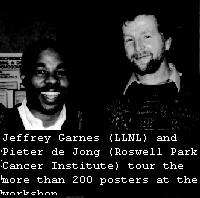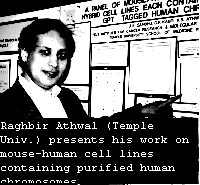Archive Site Provided for Historical Purposes

Sponsored by the U.S. Department of Energy Human Genome Program
Several speakers discussed ongoing work in constructing genomic reagents and technologies critical for mapping, gene finding, sequencing, expression studies, and molecular cytogenetics. NLGLP. Larry Deaven (LANL) and Jeff Gingrich (LLNL) announced the successful completion of NLGLP Phase II; libraries are now available for each chromosome, with 40-kb inserts in cosmids and 10-kb inserts in lambda vectors. Lambda clones are distributed through the American Type Culture Collection in Rockville, Maryland. Cosmid arrays, which have been available on a limited basis, soon will be released nonexclusively to industry to establish screening and clone-distribution services for the entire scientific community. Keeping up with demand for library copies has been difficult, Deaven noted, and the national laboratories are now seeking to share distribution with private-sector companies. LANL also completed YAC libraries with an average insert size of about 200 kb for some chromosomes, and both laboratories are exploring use of PAC and BAC vectors. [Library information (http://bbrp.llnl.gov/bbrp/genome/genome.html).]
Melvin Simon (California Institute of Technology) and Pieter de Jong (Roswell Park Cancer Institute) discussed the construction of libraries in BAC and PAC vectors, respectively, and their usefulness in providing large-fragment, stable genomic resources for mapping and sequencing. A mouse BAC library is available from Research Genetics that consists of about 145,000 clones with average insert size of 135 kb for 4x coverage and a human BAC library that provides more than 6x coverage.

Jeffrey Garnes (Lawrence Livermore National Laboratory) and Pieter de Jong (Roswell Park Cancer Institute) tour the more than 200 posters at the workshop.
BACs have been used to form contigs covering a number of regions of interest and to fill holes in YAC maps. Extensive contigs have been formed over multimegabase regions on chromosome 22; eventually, these will provide excellent substrates for sequencing chromosomes. Hundreds of cDNA, Alu-PCR, and STS probes have been used to interrogate the BAC library by hybridization and pooled PCR. All of them have successfully generated appropriate BAC contigs that can be used in gene finding and chromosome mapping.
Simon encouraged researchers to send him problem chromosome segments. Copies of a human PAC library with average insert size of 120 kb and 3x coverage have been distributed to more than 30 genome centers in North America and Europe and to commercial screening companies, including Genome Systems. A stable PAC contig has been prepared for the spinal muscular atrophy region.
Jean-Michel Vos (University of North Carolina, Chapel Hill) described a novel system to clone DNA in human cells as human artificial episomal chromosomes (HAECs) with average insert size 150 to 200 kb for mapping and sequencing and functional studies of large mammalian DNA regions. He presented data on a recently published HAEC-based human genomic library.

Raqhbir Athwal (Temple University) presents his work on mouse~human cell lines containing purified human chromosomes.
Joe Gray [University of California, San Francisco (UCSF) and LBL] reported on the LBL-UCSF Resource for Molecular Cytogenetics, which was created to develop and make available technology and reagents for molecular cytogenetic characterization of genetic diseases. Technologies include comparative genomic hybridization, FISH, and digital-imaging microscopy. These are being applied to detect and characterize DNA sequence-copy-member aberrations in human malignancies and other genetic conditions. The group is also developing a set of reagents from chromosome-specific YAC, cosmid, and P1 libraries for use as FISH probes. The goal is to develop probes distributed at about 5-Mb intervals over the entire human genome that contain STSs defining genes or genetically mapped polymorphic loci. Information about technologies, probes, and software is available at http://rmc-www.lbl.gov and will be accessible through GDB when appropriate.
David Barker (Molecular Dynamics) spoke about his group's capillary-array electrophoresis instrumentation for high-throughput DNA analysis using confocal fluorescence detection. Fragments are labeled with thiazole orange and run in eight groups of six capillaries with a replaceable hydroxyethylcellulose matrix. Total run time from sample injection to fragment resolution (up to 2 kb) is 20 to 30 min, with single-bp resolution of double-stranded restriction fragments, PCR products over 100 to 400 bp, and a total size range of 50 bp to 12 kb. Applications include mapping, sequencing, and disease diagnostics.
Another promising technique for sizing DNA fragments is single-molecule detection of a fluorescently labeled sample in a flowing stream intersected by a laser beam. Jeffrey Petty (LANL) described early results with this method for sizing larger (2- to 150-kb) DNA fragments more rapidly and accurately than is now possible using gel electrophoresis. (Fragment sizes are inferred from the fluorescence intensity of samples stained with thiazole orange.) Petty also reported progress in detecting signals from individual nucleotides; the group is working to extend the technique for rapidly sequencing 40-kb or larger DNA fragments at a rate of 100 to 1000 bases/s. This technology is being developed under the first (1991) Cooperative and Research Development Agreement (CRADA) between a DOE human genome center and a private company. John Harding leads the research group at GIBCO BRL.
Robert Lipshutz (Affymetrix) discussed applications of high-density oligonucleotide arrays (DNA probe arrays) to screen and physically map cosmid clones into contigs and to detect mutations for clinical diagnosis. For mapping applications, a fluorescently labeled target from a clone (a four-base sequence adjacent to a restriction site) is hybridized to a chip containing spatially arranged probes; this generates a pattern corresponding to a unique marker subset in the clone. Overlapping clones are detected by corre-lating hybridization patterns. Scanner instrumentation for commercial use is being developed by Molecular Dynamics and Hewlett Packard.
Maynard Olson [University of Washington, Seattle (UWS)] noted the importance of automating production of high-accuracy and -resolution restriction maps as a front end for genomic sequencing. He emphasized the need for substantially eliminating stepwise human decision making to achieve major throughput increases and meet Human Genome Project goals.
Denise Casey, HGMIS
Return to DOE Contractor-Grantee Introductory Page
The electronic form of the newsletter may be cited in the following style:
Human Genome Program, U.S. Department of Energy, Human Genome News (v6n5).
The Human Genome Project (HGP) was an international 13-year effort, 1990 to 2003. Primary goals were to discover the complete set of human genes and make them accessible for further biological study, and determine the complete sequence of DNA bases in the human genome. See Timeline for more HGP history.
Published from 1989 until 2002, this newsletter facilitated HGP communication, helped prevent duplication of research effort, and informed persons interested in genome research.